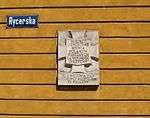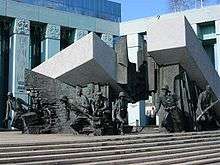Cultural representations of the Warsaw Uprising
| Warsaw Uprising |
|---|
The representation of the Warsaw Uprising in the media had already become controversial even before it began. By the time it ended in capitulation in October 1944, the questions about why no effective support had been available were in the public mind, but debate about them remained unclear in the wartime situation. After the war, information about the uprising was suppressed under communism, gradually resurfacing from the 1960s until finally in the 1990s more or less the full story could be told. The 60th anniversary in 2004 was marked by widespread discussion in the media both in Poland and through the rest of the world; this coincided with the opening of a museum of the uprising in Warsaw and many public ceremonies involving those who had fought in the uprising.
Art works immediately after the war
In 1945 Tadeusz Kulisiewicz made a series of drawings called Warsaw ruins.
Policy of People's Republic of Poland towards representing the uprising
Knowledge about the Warsaw Uprising, which had been considered inconvenient to Stalin, was twisted by propaganda of the People's Republic of Poland, which stressed the failings of Home Army and the Polish government-in-exile, and forbade all criticism of the Red Army or the political goals of Soviet strategy. Until the late 1960s, the very name of the Home Army was censored and most films and novels covering the 1944 Uprising were either banned or modified so that the name of the Home Army did not appear there. Also, the official propaganda of both Poland and the USSR suggested that the Home Army was some sort of a group of right-wing collaborators with Nazi Germany. From 1956 on, the image of Warsaw Uprising in Polish propaganda was changed a little bit to underline that the soldiers were indeed brave, while the officers were treacherous and that the commanders were characterized by disregard of the losses. The first serious publications on the topic were not issued until the late 1980s. In Warsaw, no monument to the Home Army could be built until 1989. Instead, efforts of Soviet-backed Armia Ludowa were glorified and exaggerated.
Representation in Communist propaganda
Communist propaganda related to the uprising concentrated on representing the leaders of the uprising and the politicians in London in a bad light. Immediately following the capture of the ruins of Warsaw, posters were placed around the city showing the AK leadership as the "expectant dwarfs of reaction" (Norman Davies, between pages 368 and 369).
Representation in unofficial Polish media and culture during the communist period
The courage of the Warsaw Uprising, and its utter betrayal by the Soviet Union, kept anti-Soviet sentiment high in Poland throughout the Cold War. Memories of the uprising helped to inspire the Polish labour movement Solidarity, which led a peaceful movement against the Communist government during the 1980s, leading to the downfall of that government in 1989 and the emergence of democracy.
Alongside information about the Katyn Massacre, historical information about the Warsaw Uprising was printed illegally and distributed by the Polish underground.
Representation in the West
In the West, the story of the Polish fight for Warsaw with little support, and later the shock of Home Army soldiers as Western Allies recognized the Soviet controlled pro-Communist regime installed by Stalin was an embarrassment and thus the story received little attention in the West for many years. One exception is a 1974 episode of the Thames Television documentary The World at War whose 10 minutes of coverage concludes 'thus ended one of the war's most tragic episodes'.
A key effect of the communist propaganda on representation in the west has been confusion between Warsaw Uprising and Warsaw Ghetto Uprising. This was caused partly by a simple lack of discussion of the Warsaw Uprising and partly by a deliberate mixing of the two in public discussion.
Polish band Lao Che treated the subject of Warsaw uprising their concept album "Powstanie Warszawskie".
Swedish black metal merchants Marduk treated the subject of the Warsaw uprising in their song Warschau (Warsaw spelt in German), featured on the album Plague Angel focusing on the harsh nazi reprisals and the devastation of the city via weapons like the Karl Mortar. The title was also used for the subsequent album, simply titled Warschau whose cover pictured a scene of urban desolation.
German metalcore band Heaven Shall Burn paid a tribute to the Warsaw Uprising fighters in the song "Armia" from their album Deaf to Our Prayers.
French post-punk band Varsovie was named after Warsaw city and the influence of the Warsaw Uprising is visible in its creation. The song "Varsovie" is directly related to the insurrection.
Norman Davies published Rising '44. The Battle for Warsaw in 2003.
Swedish power metal band Sabaton made the Warsaw Uprising the main theme of their song "Uprising" from the Coat of Arms album.
Post communist treatment of the Warsaw Uprising
Since 1989, the truth about the Uprising is no longer censored, and 1 August is now a celebrated anniversary. On July 31, 2004, a Warsaw Uprising Museum was opened in Warsaw (see Related links for recent news reports on this event).
Monuments to the Insurgents in Warsaw


After World War II, the communists who took the power in Poland accepted only two views of the Warsaw Uprising and the Armia Krajowa. Both could be depicted either as organization of cowards and Nazi collaborators or short-minded enemies of the people. Because of that, there could be no monument to the Warsaw Uprising anywhere in Poland. In Warsaw itself, until the late 1960s, there were only monuments to the Red Army soldiers and the Armia Ludowa soldiers. The role of the latter in the city fights in 1944 was exaggerated and overrated. Most of the victims of the Uprising who were buried in graves all over the city were later exhumed and buried in mass graves far away from the city centre, with a small concrete monument to "the victims of the war with Nazism". No mention of the Uprising was allowed.
Contrary to the communist efforts, the people of Warsaw did not forget the Uprising. The only way to express it was on Polish zaduszki day, when thousands of people lit candles on graves of the Armia Krajowa soldiers in Powązki cemetery. According to the Polish secret police, in 1983 more than 400,000 people attended the informal feast. In 1979, the first (unofficial) celebration of Warsaw Uprising anniversary took place.


In the 1970s, the Polish United Workers' Party under the lead of Edward Gierek started to seek a "Polish way to socialism" and allowed for some liberalization of Polish history. The official propaganda started to underline that although the commanders of the Armia Krajowa were criminals, the individual soldiers simply followed wrong orders. In Warsaw, some 500 stone tablets were erected to commemorate those who fell in the city during the war. The tablets were all identical, except for the dates and number of victims. The text under the monuments says: This place is sanctified with the blood of Poles who fell in fight for the freedom of the Motherland. Still no mention of the Uprising was allowed in public places.

Also, a monument to the engineers of the Soviet-backed 1st Polish Army who crossed the river in late September and tried to help the Uprising was erected in Powiśle area. However, there was no text explaining when or what for did they die. The text written on the tables around the statue of an engineer said The Free Warsaw will never forget those who started the great effort of its reconstruction (...) to the engineers who lost their lives on duty..
In 1980, the start of the Solidarity movement allowed for a committee to be created, whose purpose was to erect a monument of the Warsaw Uprising. The money was to be gathered from private sponsors since the party still did not want to participate in such an initiative. Many prominent members of the Solidarity joined the committee, but it was banned after the Martial Law was imposed in 1981. However, the communist authorities understood that the memory of the Uprising will not fade in peoples' minds and agreed to prepare a project of the monument. On July 20, 1984, an erection act was prepared. The date was chosen to blur the connection with the uprising and the feast was officially connected to July 22, the anniversary of signing the PKWN manifesto. No Armia Krajowa members were invited and the construction never started.
After the peaceful dissolution of communist system in Poland in 1989, the committee was recreated. The project by Jacek Budyna was already prepared and construction begun immediately. The Warsaw Uprising Monument (Pomnik Powstania Warszawskiego) was erected on Krasiński Square, close to the place where one of the sewer communication lines with Starówka, Żoliborz and the city centre was located. The monument was revealed on August 1, 1989.

Since the beginning of the 1990s, the monuments to the soldiers who fought in the battle were no longer banned and started to spread throughout the city. Nowadays every battalion who took part in the struggle has got a monument, a street or a square named after.
- See also: Monument to victims of the Massacre of the Wola (2004), commemorating the Wola massacre, a massacre of the population of Warsaw's Wola district by the Germans in the early days of the Warsaw Uprising.
See also
- Kanał, a Polish film released in 1956, directed by Andrzej Wajda about evacuation the defenders of the Old Town withdrew through the sewers
- Powstanie Warszawskie, a concept album of an art rock band Lao Che
- Red Plague, Red Plague a poem